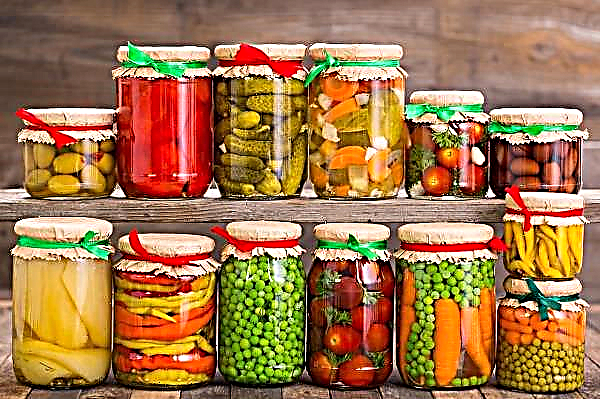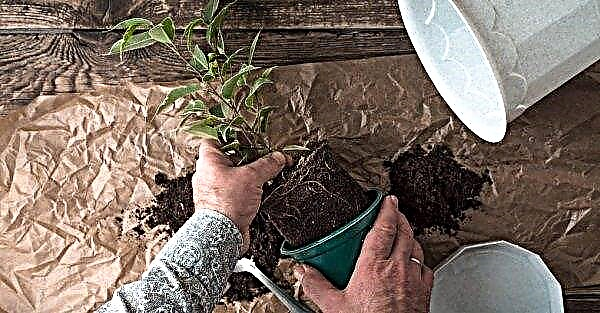For lovers of roses, the issue of sheltering bushes for the winter is relevant. It is important to cover on time so that they are not damaged by frost. Early shelter, thaws, or improper material can also lead to the death of bushes. Let's consider how, by what and when rose bushes are sheltered depending on the varieties, and what should be taken into account.
When and at what temperature to cover roses for the winter?
For wintering rose bushes need to be prepared in advance. Starting from the second half of August, it is not recommended to cut off their flowers, so as not to stimulate further vegetation, since new shoots will not be able to bloom before frost. Before covering the roses, it is necessary to remove and dispose of all the foliage and buds from them, since they can be seedlings of diseases.
When pruning, you need to leave young shoots, since in the future they will give the buds. It is necessary to pinch the shoots, remove the leaves, and treat the places of the cuts with activated carbon powder. In autumn, roses are not fed - it is better to do this in spring and early summer. But prophylactic spraying with iron or copper sulfate (3%) will protect the bush from disease.
Shelter should be no earlier than frosts come at least –5 ... –7 ° С. Frosts down to –5 ° C will only benefit the flowers and temper them.Important! You can not warm the roses for the winter too early, as this leads to the plant's aging and death. It is easier for these garden flowers to endure the first frosts than an excess of heat under cover.
How can I cover roses?
Spread bushes using dry soil, peat or humus. They fall asleep at 25-30 cm in height (1 bucket per 1 bush). The minimum layer in the presence of shelters or mild winters should be 10 cm. The soil for shelter must not be taken under roses, otherwise you can expose their roots.
Next, the bush is covered with sawdust, needles, straw or dry leaves. Rose bushes can be covered with coniferous sawdust - thanks to resins, pests and pathogenic bacteria are unlikely to get into them. In addition, they have the best thermal insulation properties and the lowest bulk density.
Coniferous sawdust has the ability to acidify the ground, so when using them it is useful to sprinkle the soil around the bush with wood ash. It will also serve as additional prevention of fungal diseases. Since sawdust has the ability to absorb moisture, experienced growers recommend mixing sawdust (2 parts) with dry peat or spruce branches (1 part).
From above it is possible to cover still with spruce branches. For regions with warm winters, such shelter is enough. In more severe conditions, it is necessary to cover the top with more lutrasil. It is breathable and will not allow the bushes to rub during thaws, which also occur in winter. As a covering material, roofing material and a polypropylene film are often used, but only by ensuring the possibility of constant monitoring and the presence of perfumes.Important! For warming, you need to use sawdust of large fractions (from 10 mm and above) and purchase those that have not been treated with pesticides. Sawdust from deciduous trees before use is recommended to be treated with Oksihom or Kuprosan, then dried.
Snow protects the bushes from freezing, but in regions with little snowy but cold winters, it is useless to hope for it. Special air-dry shelters will help here. Arcs are made above roses (for large areas) or boxes are installed, and covering materials are used from above. Often, cardboard or other insulation is placed under the film for better thermal insulation. Such shelter is important to control during warming, especially in March.
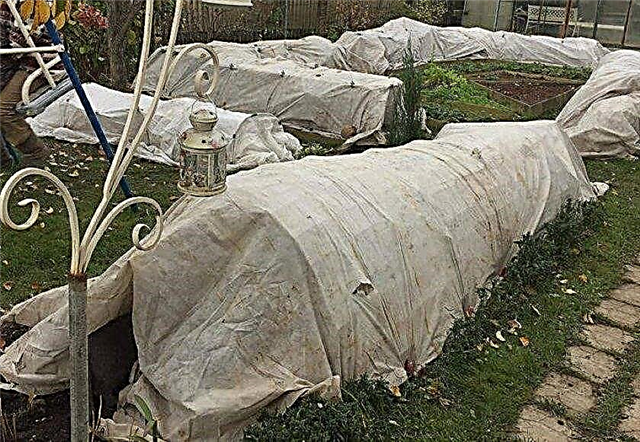
The bulk shelter showed itself well when an insulator made of dry leaves, straw, sawdust is poured into the frame erected around the rose. It is convenient and budgetary to make such a frame out of cardboard boxes and sprinkle foliage. Boxes need to be adjusted in height and width of the bush. So that the cardboard is not softened, it is covered with a waterproof film on top, under which vents are made for air exchange.
How to cover roses for the winter?
The choice of a method of sheltering roses for the period of cold weather depends not only on the region of their growth and weather, but also on the varietal group.
Wicker
Depending on the variety, they can have thin and well-bending shoots (ramblers), and can also have more powerful and stronger stems (climblers). Due to the large size, sheltering such roses is a laborious task. It is easier to work with ramblers - thin branches are easily pressed to the ground. But it’s more difficult to work with Climbers - all actions are performed gradually, in several stages, so as not to damage the plant.

After trimming, the branches should be neatly tied. They can also be wrapped in burlap and gradually bent to the ground, placed on coniferous branches. The process should be carried out at temperatures above zero, because when frosts appear, the stems lose their elasticity, and the plant can be damaged.
Branches of climbing varieties are fixed to the ground by means of boards and stones, and then sprinkled with foliage and spruce branches. In severe winters, a wire frame must be installed above them, on top of which a plastic film or roofing material is placed.
Stamp
These varieties necessarily protect from the cold. Before shelter, pruning is done, leaves and dry, damaged shoots are removed. Young specimens are carefully pressed to the ground, fixed with special brackets or hairpins.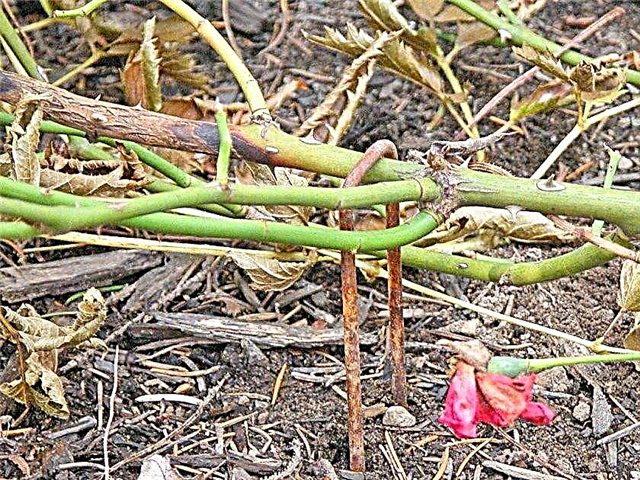
At the base, they are covered with peat, foliage or needles. Coniferous branches are placed on top and covered with a plastic wrap. Adult specimens should not be bent - you can break the stems. In this case, they put a wire frame in the form of a pyramid around the bush, and cover it with a piece of roofing material on top. Inside the structure, pine needles, leaves, sawdust are covered. Then they are wrapped with plastic wrap on top and fixed with a rope.
For these varieties, you can use the Minnesota method, but it should be noted that it is complex and can damage the bush. To do this, from the side where the stems of the plant will be directed, remove the soil layer. Then slowly tilt to the recess.
Did you know? Roses mentioned still by the ancient Greek historian Herodotus in the 5th century BC. They came to Russia only at the beginning of the XIX century, but became popular only under Catherine II (XVIII century).
At the same time, the assistant with the help of a shovel pushes the roots in the direction of the recess. Part of the rhizomes is removed from the soil. The bush is laid in a recess and fixed with studs. Part of the exposed roots are covered with a heater in the form of sawdust, peat, needles. Above placed spruce branch.
Bush
These varieties are covered on the eve of frost. Usually this is the end of October - the beginning of November. Plants are prepared for protection for the winter - they remove weak, dry shoots, foliage and cut bushes at 0.3–0.4 of their height. Then carry out chemical treatment against the appearance of fungi and mold (Bordeaux liquid, Inta-Vir).
Shelter from the cold can be done in several ways:
- Install special huts. They are made of wide panels or boards, which are covered with polyethylene on top. It is convenient to ventilate this design by lifting the side of the board or panel.

- For a climate with mild winters, it is enough to carry out the hilling of the bush using soil, peat or mulch. It’s better to put spruce branches on top or cover it with dry leaves.
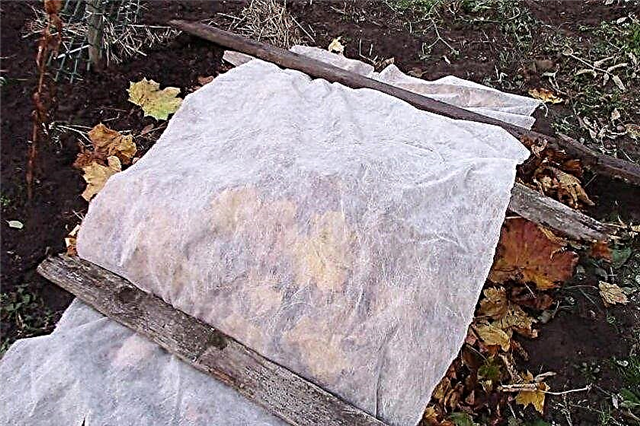
- Dry way. Usually, valuable specimens of flowers are covered in this way. Cut the rose or carefully place the stems on the ground, securing them with special brackets. Top lay with spruce branches or fall asleep with dry foliage. Around put boards or pegs on which to place mats. Wrap a plastic film on top, the edges of which are fixed with stones. One part of the end face is opened for ventilation.

Park
These varieties are hardy, therefore, in areas of growth with a warm climate, without strong frosts, they can not be covered. If winters are cold, or the rose bushes are too young, they are best protected.
For the shelter procedure for the winter, you should first prepare:Did you know? Even the ancient Roman writer Pliny, who lived shortly before the beginning of our era, wrote about white roses, and it is assumed that they are. They were popular in the Middle Ages and were the heraldic symbol of the royal dynasty of York in England.
- in August stop loosening and watering the plants;
- before shelter pruning to form a bush, while removing old and damaged shoots;
- until the first frosts bushes are healed to a height of 16–20 cm using peat and loose soil.
You can use a spruce branch for shelter, which is wrapped with polyethylene on top and covered with soil or peat. It is also good to protect from the cold to use wooden boxes, on top of which to lay roofing. If it is impossible to make a vertical shelter, the park rose is carefully bent. This should be done gradually, since their branches are rigid. They are tied and fixed with brackets or crushed by improvised materials. Then insulate from above.
If it is impossible to make a vertical shelter, the park rose is carefully bent. This should be done gradually, since their branches are rigid. They are tied and fixed with brackets or crushed by improvised materials. Then insulate from above.
Ground cover
These varieties tolerate frosts well, and they have enough snow as a heater. But if the frost hits without precipitation in the form of snow, the flowers may freeze. Since such roses grow low to the ground, it is better to cover them with coniferous branches or lutrasil.
Floribunda
These varieties need to be insulated for the winter. In the beginning, in the fall, the stems are trimmed so that 26-30 cm remains above the ground. Preventive treatment of the truncated stems with 3% Bordeaux liquid or another preparation containing copper should be carried out. Then the cut stems are covered with soil or peat. About 1 bucket leaves for 1 bush.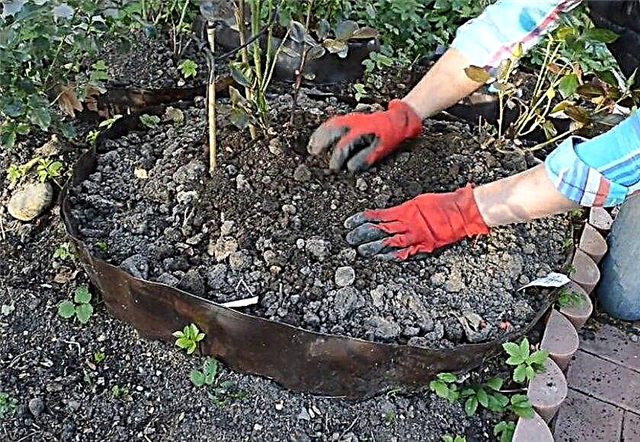
Very young bushes can be wrapped with lutrasil. Warm from above with sawdust, leaves or spruce branches. This is best done closer to frost. When frosts appear –6 ... –7 ° С, a film is placed on top of the flouribundes that are covered in to protect them from moisture and cold wind gusts.
Cuttings
If the process of grafting flowers occurred in the summer, you do not need to remove the cans from the cuttings. They should be insulated by falling asleep with leaves, sawdust or pine branches, and then covered with polyethylene on top. Such insulation is removed in the spring, and banks are cleaned in the summer.
These flowers do not tolerate cold gusts of wind, as well as stagnation of water, which often occurs when ice and snow melt. To eliminate this cause of stagnation, you need to dig small trenches to drain melt water.
Cuttings are carried out not only in summer but also in autumn. For this purpose, cut out pencil-sized shoots with a well-sharpened knife or garden shears and store in several ways:
- Dig in the area of the recess 15-16 cm. But the bottom is placed a piece of cotton fabric. Leaves are removed from the cut shoots and placed in a recess so that they do not touch. Top cover with a cloth and cover with soil.
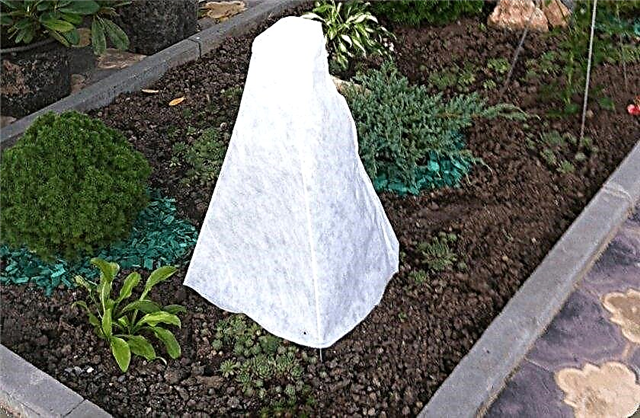
- A stalk is wrapped in sphagnum moss, which are pre-sprayed with Fitosporin. After wrapping the film and placed for storage in the cellar.

- On the balcony. With such storage, a layer of expanded clay is poured into the bucket, then the soil for roses with the addition of perlite. After everything is watered with water. The cutlery is placed in water, and then in a growth stimulator. A small hole is made in the prepared soil and a stalk is planted.
 The bucket is covered with plastic wrap and a blanket. Then placed on the balcony in a place where it is warm and light. In positive weather, periodically remove the shelter and ventilate, but when severe colds occur, the bucket is transferred to the room.
The bucket is covered with plastic wrap and a blanket. Then placed on the balcony in a place where it is warm and light. In positive weather, periodically remove the shelter and ventilate, but when severe colds occur, the bucket is transferred to the room.
Is it possible not to shelter roses?
Not all roses should be covered in the cold. There are varieties that are highly resistant to frost. Climatic conditions influence the need to cover such roses for the winter. Winters without severe frosts can tolerate certain varieties that are not cold-resistant. These are formerly hybrid tea species.
The following varieties are most resistant to frost:
- Park - Ritausma, Pink Grotendorst, Konrad Ferdinand Meyer, Agnes, Hansa, Lavinia and others.
- Species (or dogrose) - varieties of nitide, wrinkled and others. Many varietal rose hips were obtained on the basis of the rose Rugosa. This variety also gave the ability to tolerate frost and give an abundant color.
- Specific Alba Rose Hybrids (Alba Maxima, Alba Plena), spinozissima, rugosa.
The most frost-resistant varieties are considered Scabroza Snow Pavement, Jens Munch, John Davis, Hanza and others, most of which are park roses based on rose hips.
Canadian park roses are especially resistant to frost, such as the semi-climbing roses Henry Kelsey and John Cabot, the truly climbing roses John Davis and Quadra. Canadians advise them to grow root crops.
Florists recommend protecting other varieties with shelter in cold weather.
Did you know? The breeder Rudolf Geschwind (1829–1910) was the first to seriously engage in raising the resistance of roses to severe frosts. He began to cross wild rose specimens from Siberia, North America, China, Central Asia and received many varieties with this ability to varying degrees.
Correctly and on time, covered roses will be wintered until spring without problems, but their condition must be monitored during warming and in time to remove the shelter in the spring.






 The bucket is covered with plastic wrap and a blanket. Then placed on the balcony in a place where it is warm and light. In positive weather, periodically remove the shelter and ventilate, but when severe colds occur, the bucket is transferred to the room.
The bucket is covered with plastic wrap and a blanket. Then placed on the balcony in a place where it is warm and light. In positive weather, periodically remove the shelter and ventilate, but when severe colds occur, the bucket is transferred to the room.
